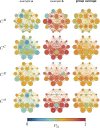Impact of biological rhythms on the importance hierarchy of constituents in time-dependent functional brain networks
- PMID: 37705698
- PMCID: PMC10497113
- DOI: 10.3389/fnetp.2023.1237004
Impact of biological rhythms on the importance hierarchy of constituents in time-dependent functional brain networks
Abstract
Biological rhythms are natural, endogenous cycles with period lengths ranging from less than 24 h (ultradian rhythms) to more than 24 h (infradian rhythms). The impact of the circadian rhythm (approximately 24 h) and ultradian rhythms on spectral characteristics of electroencephalographic (EEG) signals has been investigated for more than half a century. Yet, only little is known on how biological rhythms influence the properties of EEG-derived evolving functional brain networks. Here, we derive such networks from multiday, multichannel EEG recordings and use different centrality concepts to assess the time-varying importance hierarchy of the networks' vertices and edges as well as the various aspects of their structural integration in the network. We observe strong circadian and ultradian influences that highlight distinct subnetworks in the evolving functional brain networks. Our findings indicate the existence of a vital and fundamental subnetwork that is rather generally involved in ongoing brain activities during wakefulness and sleep.
Keywords: circadian rhythm; edge centrality; electroencephalographic signals; functional brain network; vertex centrality.
Copyright © 2023 Bröhl, von Wrede and Lehnertz.
Conflict of interest statement
The authors RvW and KL declared that they were editorial board members of Frontiers, at the time of submission. This had no impact on the peer review process and the final decision. The remaining author declares that the research was conducted in the absence of any commercial or financial relationships that could be construed as a potential conflict of interest.
Figures





Similar articles
-
Time in Brain: How Biological Rhythms Impact on EEG Signals and on EEG-Derived Brain Networks.Front Netw Physiol. 2021 Sep 27;1:755016. doi: 10.3389/fnetp.2021.755016. eCollection 2021. Front Netw Physiol. 2021. PMID: 36925573 Free PMC article.
-
Multiscale Time-resolved Analysis Reveals Remaining Behavioral Rhythms in Mice Without Canonical Circadian Clocks.J Biol Rhythms. 2022 Jun;37(3):310-328. doi: 10.1177/07487304221087065. Epub 2022 May 16. J Biol Rhythms. 2022. PMID: 35575430 Free PMC article.
-
Iterative Metaplasticity Across Timescales: How Circadian, Ultradian, and Infradian Rhythms Modulate Memory Mechanisms.J Biol Rhythms. 2022 Feb;37(1):29-42. doi: 10.1177/07487304211058256. Epub 2021 Nov 15. J Biol Rhythms. 2022. PMID: 34781753 Free PMC article. Review.
-
Analysis of sleep-wakefulness rhythms in male rats after suprachiasmatic nucleus lesions and ocular enucleation.Brain Res. 1977 Feb 11;122(1):33-47. doi: 10.1016/0006-8993(77)90660-6. Brain Res. 1977. PMID: 837222
-
Ultradian and circadian rhythms of sleep-wake and food-intake behavior during early infancy.Chronobiol Int. 1999 Mar;16(2):129-48. doi: 10.3109/07420529909019081. Chronobiol Int. 1999. PMID: 10219486 Review.
Cited by
-
The time-evolving epileptic brain network: concepts, definitions, accomplishments, perspectives.Front Netw Physiol. 2024 Jan 16;3:1338864. doi: 10.3389/fnetp.2023.1338864. eCollection 2023. Front Netw Physiol. 2024. PMID: 38293249 Free PMC article. Review.
-
Functional Importance Backbones of the Brain at Rest, Wakefulness, and Sleep.Brain Sci. 2025 Jul 20;15(7):772. doi: 10.3390/brainsci15070772. Brain Sci. 2025. PMID: 40722362 Free PMC article.
-
Stable Yet Destabilised: Towards Understanding Brain Network Dynamics in Psychogenic Disorders.J Clin Med. 2025 Jan 21;14(3):666. doi: 10.3390/jcm14030666. J Clin Med. 2025. PMID: 39941337 Free PMC article.
-
Time-Resolved Information-Theoretic and Spectral Analysis of fNIRS Signals from Multi-Channel Prototypal Device.Entropy (Basel). 2025 Jun 28;27(7):694. doi: 10.3390/e27070694. Entropy (Basel). 2025. PMID: 40724411 Free PMC article.
References
-
- Bavelas A. (1950). Communication patterns in task-oriented groups. J. Acoust. Soc. Am. 22, 725–730. 10.1121/1.1906679 - DOI
-
- Boashash B. (1992). Time frequency signal analysis: Methods and applications. Melbourne: Longman Cheshire.
-
- Boccaletti S., Latora V., Moreno Y., Chavez M., Hwang D.-U. (2006). Complex networks: structure and dynamics. Phys. Rep. 424, 175–308. 10.1016/j.physrep.2005.10.009 - DOI
LinkOut - more resources
Full Text Sources

